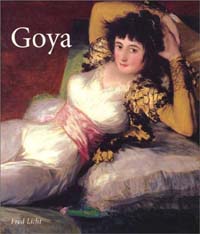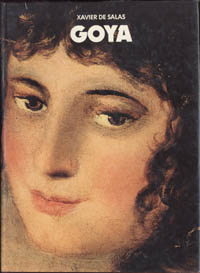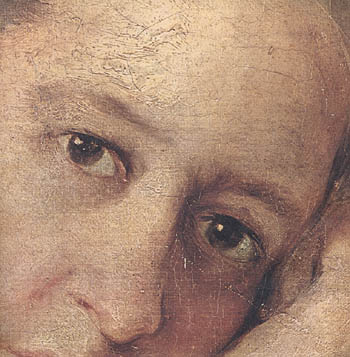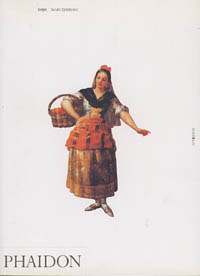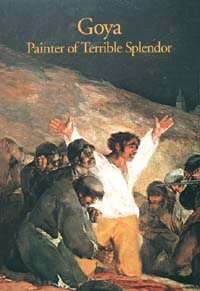14 Different books reviewed or described below:
GOYA BOOKS- - - - - - - - - - - - - - - - -
-
-
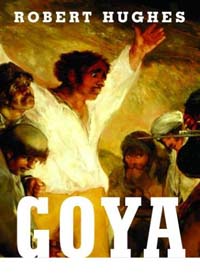
Goya
By Robert Hughes
Published by Alfred Knopf, November 2003
ISBN 0394580281
448 pages
Printed in Spain
PURCHASE AT AMAZON.COM(Softcover, from $19.00
Dustjacket text here.
This book appears to have grown out of the review essay Hughes wrote in 1989 for the Goya in the Age of Enlightenment exhibit in New York City. He cannibalizes a number of the phrases and ideas he used in that essay, and has added a great deal more to flesh out this 448 page book.
Motivated by an affection (which is obvious on these pages) for his subject, and also a seeming identification, Hughes travels through the history of Goya's life and his artwork with hard words for (what he supposes) are Goya's enemies, understanding for Goya's friends and affections, and some back-and-forth on what are the real facts about the various legends that are thrown up around the Spanish painter. At times, Hughes moves very fast through events, and he is apparently more excited to discuss some things (for example, the Duchess of Alba, or the Maja Desnuda) versus some other things (e.g., The Milkmaid of Bordeaux.) Hughes energy and easy writing style makes this book sometimes much less an art history book versus a kind of personal journey into Goya, with Hughes as the enthusiastic guide.
The reproduction quality of the images in this book are excellent, though too small (the volume is 9.5" x 11", approximately) and I came across but one production error (a typo) in all of these many pages. A thorough review addressing some of the ideas in Hughes book will be presented on the next major update here on the Goya site.- (Below) An anonymous rebut to Hughes' book which I received via e-mail:
 On the Hughes bio, the reviewer mentions
finding only one typo. I found several,
the most obvious being the mistaken
citation of "Ben Turpin"
for "Dick Turpin" in discussing
the English semi-legendary highwayman
(Ben Turpin was a silent film comedian).
There are others; but I was most struck
by Hughes's discussion of Allegory
of the Constitution (pp 270-271),
in which either the figure or the
one Hughes references is reversed;
right means left. It is odd that anyone
who examines the text with any attentiveness
would not have picked up on this point.
At other points, there are discrepancies
between titles of works, as they are
captioned and as they are cited in
the text. One senses a somewhat cursory
copy-edit; and that Hughes himself
may not have emerged from his accident
with a good command of his observational
abilities. One other point: I DO find
the quality and small size of the
figures to be problematical. I found
it difficult to identify many of the
details Hughes cited in his commentary.
On the Hughes bio, the reviewer mentions
finding only one typo. I found several,
the most obvious being the mistaken
citation of "Ben Turpin"
for "Dick Turpin" in discussing
the English semi-legendary highwayman
(Ben Turpin was a silent film comedian).
There are others; but I was most struck
by Hughes's discussion of Allegory
of the Constitution (pp 270-271),
in which either the figure or the
one Hughes references is reversed;
right means left. It is odd that anyone
who examines the text with any attentiveness
would not have picked up on this point.
At other points, there are discrepancies
between titles of works, as they are
captioned and as they are cited in
the text. One senses a somewhat cursory
copy-edit; and that Hughes himself
may not have emerged from his accident
with a good command of his observational
abilities. One other point: I DO find
the quality and small size of the
figures to be problematical. I found
it difficult to identify many of the
details Hughes cited in his commentary. 
-
- - - - - - - - - - - - - - - - -
Buy
the book off the Abbeville website here.
(We don't get anything if you order from this page. Abbeville Press sent us a copy of the book to review and we very much appreciate it.) (Below:
From the dustjacket of Fred Licht's book Goya)
 |
- - - - - - - - - - - - - - - - -
Goya Xavier de Salas writing on Goya in this volume has the warm, easy pace of someone who has handled the subject over and over (Salas' author credit says that he has produced over 180 books). He seems more concerned with explaining the basics for the reader versus charging into any thick and weighty debate, which is a nice difference since the subject of Goya typically provokes easy argumentation. While de Salas flatly declares which way he stands on a number of issues (for example, the supposed affair between Goya & the Duchess of Alba, i.e., it didn't happen), he also presents the reasoning behind the opposite position. This is done in a deferential manner, and with great tact, which, I think, reveals the Spanish culture that de Salas is writing from (this book is an English translation from the Spanish). American writers, particularly with regards to Goya, have things to prove, and don't have time for such niceties, which can conjure a sort of high school debate atmosphere to a book written in that way. Which speaks all the more to the grace of de Salas' volume. He writes in a straight forward, authoritative manner, and has a personal tone toward the reader. Salas approaches Goya as if he were an artist and a man, not a god, which is a tendency with some art historians. Perhaps this is because for de Salas, Goya is a talented and thoughtful countryman, not a foreign genius and peg to hang modernist art theory upon. Considering its age, the production qualities on this 9.5" x 13" book holds up well. While much of the reproduction on the images are poor by comparison to any modern book published since the 1980s, there is a certain quality to the photography which is not found in modern techniques. Chiefly this is in the instances when a paintings surface is in relief, such that brush strokes can be seen in the color. This is a fascinating attribute that does not show up in newer books, since the aim in reproduction is capturing the flatness of the painting. (Example below, detail from the portrait of Gaspar Melchor Jovellanos, 1798)
|
- - - - - - - - - - - - - - - - -
- - - - - - - - - - - - - - - - -
Eyewitness
Art: Goya There
is a 1999 edition of this work with a different cover.
I do not know if the contents were revised from the
earlier 1993 version. To see the current edition for
sale, you can go to the DK books web site here or to Amazon.com here. This is an excellent volume for children with serious interests in the fine arts. The reproduction quality is very good, and Wright's concise, short written notes provides a sort of illustrated timeline overview of Goya's work and life. Includes analysis and excerpts of Goya's private letters, "key" biographies, glossary of words, and a map showing the locations of museums and galleries owning at least five Goya paintings (I noticed that the USA National Gallery is not mentioned: they have more than five). Although these DK books (in the Eyewitness Art series) are directed at a certain young age group, I have picked up the volume many times for reference. It covers so much in such a short "blurb" style that it's a handy reference tool. It also shows off the kind of analysis that is not easy to find elsewhere, for example pages 14 and 15 which break down Goya's "The Parasol" into picture elements, showing the color palette used and kinds of brush strokes. The graphic design of the pages are not unlike that of a magazine in some way. It is crammed with text and imagery that utilizes all of the available space, and the photographs of unusual odds and ends (for example, page 17 has a foto of Goya's actual etching plate for Sebastian de Morra along with a copy of the print itself) is interesting and personable. I wish there was an equivalent "adult" version of this kind of book that was as lively in it's design and images, though with a greater emphasis on written information. That is not a negative remark against the 64 pages making up Wright's book, rather a simple note of space limitations. (below)
The dust jacket flaps from the book
|
- - - - - - - - - - - - - - - - -
This is a good, inexpensive volume for introducing Goya to those with a marginal interest or who are perhaps relatively young adult readers. The printing quality varies to sometimes too dark in the reproductions, but they are otherwise clear and sharp (though small - - the volume itself measures roughly 7" x 5").
|
- - - - - - - - - - - - - - - - -
Goya Francisco: Los Caprichos (Dover Books, 1969)
Goya,
Francisco: Disasters Of War (Dover
Publications, 1967)
Malraux,
Andre. Saturn: An Essay On Goya. Phaidon,
1957 . 4to. 184pp.
Schilderijen,Mayer,
A. Hyatt : Goya, 67 Drawings (New York
Graphic Society, 1974)
Milner,
Frank: Goya (112 pages, Smithmark,
1995)
Myers, Bernard: Goya (Spring Books, 1964)
Richard
: The World of Goya (Time-Life Series,
1968)
Wolf
Reva: Goya And The Satirical Print In England
And On The Continent, 1730 To 1850 (Godine, David R Publ Inc)
(Special New, Trade Paper, Burnside)
|
- - - - - - - - - - - - - - - - -
- - - - - - - - - - - - - - - - -
WEB
SITE COPYRIGHT©1997-2006 ERIK E. WEEMS
IMAGES ARE COPYRIGHT TO THEIR RESPECTIVE OWNERS
http://www.eeweems.com/goya/books.html
BIO | ARTWORK | BOOKS | RESOURCES FOR STUDENTS | LINKS | CONTACT | NEWS | STATS | F.A.Q.

